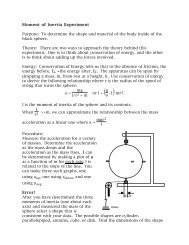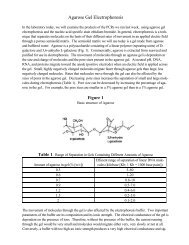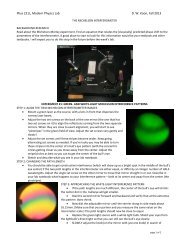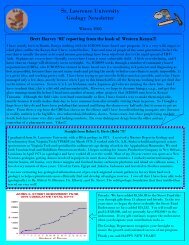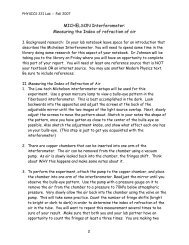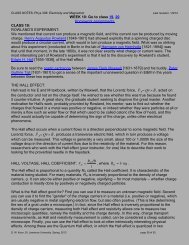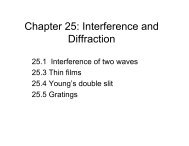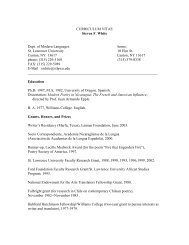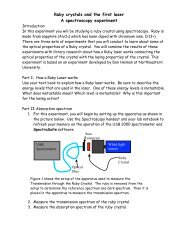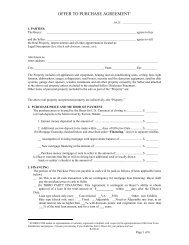TOPO TA Cloning (Invitrogen)
TOPO TA Cloning (Invitrogen)
TOPO TA Cloning (Invitrogen)
Create successful ePaper yourself
Turn your PDF publications into a flip-book with our unique Google optimized e-Paper software.
<strong>TOPO</strong> <strong>TA</strong> <strong>Cloning</strong> ®Version N07260125-0184<strong>TOPO</strong> <strong>TA</strong> <strong>Cloning</strong> ®Five-minute cloning of Taq polymerase-amplifiedPCR productsCatalog nos. K4500-01, K4500-40, K4520-01, K4520-40, K4550-01, K4550-40,K4560-01 (pCR ® 2.1-<strong>TOPO</strong> ® )Catalog nos. K4600-01, K4600-40, K4620-01, K4620-40, K4650-01, K4650-40,K4660-01 (pCR ® II-<strong>TOPO</strong> ® )A Limited Label License covers this product (see Purchaser Notification). By use of thisproduct, you accept the terms and conditions of the Limited Label License.www.invitrogen.comtech_service@invitrogen.com
Table of ContentsTable of Contents................................................................................................................................................iiiKit Contents and Storage..................................................................................................................................ivQualifying the Product......................................................................................................................................viiPurchaser Notification.....................................................................................................................................viiiMETHODS ...................................................................................................................... 1Overview ................................................................................................................................................................1Producing PCR Products...................................................................................................................................3<strong>TOPO</strong> ® <strong>Cloning</strong> Reaction and Transformation .............................................................................................4Optimizing the <strong>TOPO</strong> ® <strong>Cloning</strong> Reaction.......................................................................................................9Map of pCR ® 2.1-<strong>TOPO</strong> ® ....................................................................................................................................10Map of pCR ® II-<strong>TOPO</strong> ® .......................................................................................................................................11<strong>TOPO</strong> <strong>TA</strong> <strong>Cloning</strong> ® Control Reactions..........................................................................................................12APPENDIX.................................................................................................................... 15Purifying PCR Products ...................................................................................................................................15Addition of 3´ A-Overhangs Post-Amplification.........................................................................................17Recipes .................................................................................................................................................................18Technical Service...............................................................................................................................................19References...........................................................................................................................................................21iii
Kit Contents and StorageShipping andStorage<strong>TOPO</strong> <strong>TA</strong> <strong>Cloning</strong> ® Kits are shipped on dry ice. Each kit contains a box with <strong>TOPO</strong> <strong>TA</strong><strong>Cloning</strong> ® reagents (Box 1) and a box with One Shot ® Chemically Competent orElectrocomp cells (Box 2). Store Box 1 at -20°C and Box 2 at -80°C.Types of <strong>TOPO</strong> <strong>TA</strong><strong>Cloning</strong> ® Kits<strong>TOPO</strong> <strong>TA</strong> <strong>Cloning</strong> ® Kits are available with either pCR ® 2.1-<strong>TOPO</strong> ® or pCR ® II-<strong>TOPO</strong> ®and either DH5α -T1 R , TOP10 or TOP10F´ One Shot ® Chemically Competent cells orTOP10 One Shot ® Electrocomp cells (see page vi for the genotypes of the strains).Product Reactions One Shot ® Cells Type of Cells Catalog no.<strong>TOPO</strong> <strong>TA</strong> <strong>Cloning</strong> ® Kit 20 TOP10 chem. competent K4500-01(containing pCR ® 2.1-<strong>TOPO</strong> ® ) 40 TOP10 chem. competent K4500-4020 DH5α-T1 R chem. competent K4520-0140 DH5α-T1 R chem. competent K4520-4020 TOP10F´ chem. competent K4550-0140 TOP10F´ chem. competent K4550-4020 TOP10 electrocompetent K4560-01<strong>TOPO</strong> <strong>TA</strong> <strong>Cloning</strong> ® Kit Dual Promoter 20 TOP10 chem. competent K4600-01(containing pCR ® II-<strong>TOPO</strong> ® ) 40 TOP10 chem. competent K4600-4020 DH5α-T1 R chem. competent K4620-0140 DH5α-T1 R chem. competent K4620-4020 TOP10F´ chem. competent K4650-0140 TOP10F´ chem. competent K4650-4020 TOP10 electrocompetent K4660-01continued on next pageiv
Kit Contents and Storage, continued<strong>TOPO</strong> <strong>TA</strong> <strong>Cloning</strong> ®Reagents<strong>TOPO</strong> <strong>TA</strong> <strong>Cloning</strong> ® reagents (Box 1) are listed below. Please note that the user mustsupply Taq polymerase. Store Box 1 at -20°C.Item Concentration AmountpCR ® 2.1-<strong>TOPO</strong> ® orpCR ® II-<strong>TOPO</strong> ®10 ng/µl plasmid DNA in:;50% glycerol50 mM Tris-HCl, pH 7.4 (at 25°C)1 mM ED<strong>TA</strong>1 mM DTT0.1% Triton X-100100 µg/ml BSAphenol red20 µl10X PCR BufferSalt SolutiondNTP Mix100 mM Tris-HCl, pH 8.3 (at 42°C)500 mM KCl25 mM MgCl 20.01% gelatin100 µl1.2 M NaCl0.06 M MgCl 250 µl12.5 mM dATP; 12.5 mM dCTP12.5 mM dGTP; 12.5 mM dTTPneutralized at pH 8.0 in water10 µlM13 Forward (-20) Primer 0.1 µg/µl in TE Buffer 20 µlM13 Reverse Primer 0.1 µg/µl in TE Buffer 20 µlControl Template 0.1 µg/µl in TE Buffer 10 µlControl PCR Primers 0.1 µg/µl each in TE Buffer 10 µlSterile Water -- 1 mlSequence ofPrimersThe table below describes the sequence and pmoles supplied of the sequencing primersincluded in this kit.Primer Sequence pMoles SuppliedM13 Forward (-20) 5´-G<strong>TA</strong>AAACGACGGCCAG-3´ 407M13 Reverse 5´-CAGGAAACAGC<strong>TA</strong>TGAC-3´ 385continued on next pagev
Kit Contents and Storage, continuedOne Shot ®ReagentsThe table below describes the items included in each One Shot ® competent cell kit. Storeat -80°C.Item Composition AmountSOC Medium(may be stored at +4°C orroom temperature)2% Tryptone0.5% Yeast Extract10 mM NaCl2.5 mM KCl10 mM MgCl 26 mlDH5α-T1 R ORTOP10 cells ORTOP10F´ cellspUC18 ORpUC19 Control DNA10 mM MgSO 420 mM glucoseChemically CompetentChemically Competent or Electrocomp Chemically Competent only10 ng/µl in TE, pH 810 pg/µl in 5 mM Tris-HCl, 0.5 mMED<strong>TA</strong>, pH 821 x 50 µl10 µl50 µlGenotypes ofE. coli StrainsDH5α-T1 R : Use this strain for general cloning and blue/white screening without IPTG.Strain is resistant to T1 bacteriophage.F- φ80lacZ∆M15 ∆(lacZYA-argF)U169 deoR recA1 endA1 hsdR17(r - k , m + k ) phoAsupE44 thi-1 gyrA96 relA1 tonA (confers resistance to phage T1)TOP10: Use this strain for general cloning and blue/white screening without IPTG.F - mcrA ∆(mrr-hsdRMS-mcrBC) Φ80lacZ∆M15 ∆lacΧ74 recA1 deoR araD139 ∆(araleu)7697galU galK rpsL (Str R ) endA1 nupGTOP10F´: This strain overexpresses the Lac repressor (lacI q gene). For blue/whitescreening, you will need to add IPTG to the plates to obtain expression from the lacpromoter. This strain contains the F episome and can be used for single-strand rescue ofplasmid DNA containing an f1 origin.F´ {lacI q Tn10 (Tet R )} mcrA ∆(mrr-hsdRMS-mcrBC) Φ80lacZ∆M15 ∆lacΧ74 recA1deoR araD139 ∆(ara-leu)7697 galU galK rpsL (Str R ) endA1 nupGvi
Qualifying the ProductRestriction DigestSupercoiled pCR ® 2.1-<strong>TOPO</strong> ® and pCR ® II-<strong>TOPO</strong> ® are qualified by restriction digest.The table below lists the restriction enzymes and the expected fragments.Restriction Enzyme pCR ® 2.1-<strong>TOPO</strong> ® pCR ® II-<strong>TOPO</strong> ®Hind III (linearizes) 3890 bp 3932 bpXba I (linearizes) 3890 bp 3932 bpNsi I 3890 bp 96, 3836 bpPst I 1167, 2723 bp 1167, 2765 bpEcoR I and Afl III 408, 693, 2789bp 450, 693, 2789 bp<strong>TOPO</strong> ® <strong>Cloning</strong>EfficiencyOnce the vectors have been adapted with topoisomerase I, they are lot-qualified usingthe control reagents included in the kit. Under conditions described on pages 12-14, a750 bp control PCR product was <strong>TOPO</strong> ® -Cloned into each vector and subsequentlytransformed into the One Shot ® competent E. coli included with the kit.Each lot of vector should yield greater than 95% cloning efficiency.PrimersBoth primers have been lot-qualified by DNA sequencing experiments using thedideoxy chain termination technique.One Shot ®Competent E. coliAll competent cells are tested for transformation efficiency using the control plasmid.Transformed cultures are plated on LB plates containing 100 µg/ml ampicillin and thetransformation efficiency is calculated. Test transformations are performed in duplicate.Transformation efficiency should be ~1 x 10 9 cfu/µg DNA.In addition, untransformed cells are tested for appropriate antibiotic sensitivity and lackof phage contamination. DH5α-T1 R is also tested for resistance to phage T5, a standardtest for resistance to phage T1.vii
Purchaser Notification<strong>Cloning</strong>Technology LabelLicenseThe consideration paid for <strong>Cloning</strong> Technology products (e.g., <strong>TOPO</strong> ® <strong>Cloning</strong>, <strong>TOPO</strong><strong>TA</strong> <strong>Cloning</strong> ® , <strong>TA</strong> <strong>Cloning</strong> ® , <strong>TOPO</strong> ® Tools, Directional <strong>TOPO</strong> ® <strong>Cloning</strong>, ZeroBackground , GATEWAY <strong>Cloning</strong> Systems and Echo <strong>Cloning</strong> Systems) grants aLimited License with a paid up royalty to use the product pursuant to the terms set forthin the accompanying Limited Label License (see below).The <strong>Cloning</strong> Technology products and their use are the subject of U.S. Patent Nos.5,888,732, 6,143,557, 6,171,861, 5,766,891, 5,487,993, 5,827,657, 5,910,438,6,180,407, 5,851,808, and/or other pending U.S. and foreign patent applications ownedby or licensed to <strong>Invitrogen</strong> Corporation. Use of these products requires a license from<strong>Invitrogen</strong>. Certain limited nontransferable rights are acquired with the purchase of theseproducts (see below).The purchase price of these products includes limited, nontransferable rights to use onlythe purchased amount of the product solely for internal research. <strong>Invitrogen</strong> reserves allother rights and in particular, the purchaser of this product may not transfer or otherwisesell this product or its components or derivatives to a third party and no rights areconveyed to the purchaser to use the product or its components or derivatives forcommercial purposes as defined below.Commercial purposes means any activity for which a party receives consideration andmay include, but is not limited to, (1) use of the product or its components or derivativesin manufacturing, (2) use of the product or its components or derivatives to provide aservice, information or data, (3) use of the product or its components or derivatives fordiagnostic purposes, (4) transfer or sell vectors, clones, or libraries made with theproduct or components or derivatives of the product, or (5) resell the product or itscomponents or derivatives, whether or not such product or its components or derivativesare resold for use in research.If the purchaser is not willing to accept these use limitations, <strong>Invitrogen</strong> is willing toaccept return of the product for a full refund. For information on obtaining a license,contact the Director of Licensing, 1600 Faraday Avenue, Carlsbad, California 92008.Phone (760) 603-7200. Fax (760) 602-6500.viii
MethodsOverviewIntroduction<strong>TOPO</strong> <strong>TA</strong> <strong>Cloning</strong> ® *provides a highly efficient, 5-minute, one-step cloning strategy("<strong>TOPO</strong> ® <strong>Cloning</strong>") for the direct insertion of Taq polymerase-amplified PCR productsinto a plasmid vector. No ligase, post-PCR procedures, or PCR primers containingspecific sequences are required.How It WorksThe plasmid vector (pCR ® II-<strong>TOPO</strong> ® or pCR ® 2.1-<strong>TOPO</strong> ® ) is supplied linearized with:• Single 3´-thymidine (T) overhangs for <strong>TA</strong> <strong>Cloning</strong> ®• Topoisomerase I covalently bound to the vector (referred to as "activated" vector)Taq polymerase has a nontemplate-dependent terminal transferase activity that adds asingle deoxyadenosine (A) to the 3´ ends of PCR products. The linearized vector suppliedin this kit has single, overhanging 3´ deoxythymidine (T) residues. This allows PCRinserts to ligate efficiently with the vector.Topoisomerase I from Vaccinia virus binds to duplex DNA at specific sites and cleavesthe phosphodiester backbone after 5′-CCCTT in one strand (Shuman, 1991). The energyfrom the broken phosphodiester backbone is conserved by formation of a covalent bondbetween the 3′ phosphate of the cleaved strand and a tyrosyl residue (Tyr-274) oftopoisomerase I. The phospho-tyrosyl bond between the DNA and enzyme cansubsequently be attacked by the 5′ hydroxyl of the original cleaved strand, reversing thereaction and releasing topoisomerase (Shuman, 1994).TopoisomeraseTyr-274OPOHCCCTTGGGAPCR ProductATyr-274A AGGGTTCCCHOPOTopoisomerasecontinued on next page1
Overview, continuedExperimentalOutline• Produce Your PCR Product• Set Up <strong>TOPO</strong> ® <strong>Cloning</strong> Reaction (Mix Together PCR Product and <strong>TOPO</strong> ® Vector)• Incubate 5 Minutes at Room Temperature• Transform <strong>TOPO</strong> ® <strong>Cloning</strong> Reaction into One Shot ® Competent Cells• Select and Analyze 10 White or Light Blue Colonies for Insert2
Producing PCR ProductsIntroductionIt is important to properly design your PCR primers to ensure that you obtain the productyou need for your studies. Once you have decided on a PCR strategy and havesynthesized the primers you are ready to produce your PCR product. Remember thatyour PCR product will have single 3´ adenine overhangs.NoteDo not add 5´ phosphates to your primers for PCR. The PCR product synthesized will notligate into pCR ® 2.1-<strong>TOPO</strong> ® or pCR ® II-<strong>TOPO</strong> ® .Materials Suppliedby the UserYou will need the following reagents and equipment.• Taq polymerase• Thermocycler• DNA template and primers for PCR productPolymeraseMixturesIf you wish to use a mixture containing Taq polymerase and a proofreading polymerase,Taq must be used in excess of a 10:1 ratio to ensure the presence of 3´ A-overhangs onthe PCR product (i.e. Expand or eLONGase ).If you use polymerase mixtures that do not have enough Taq polymerase or a proofreadingpolymerase only, you can add 3′ A-overhangs using the method on page 17.Producing PCRProducts1. Set up the following 50 µl PCR reaction. Use less DNA if you are using plasmidDNA as a template and more DNA if you are using genomic DNA as a template.Use the cycling parameters suitable for your primers and template. Be sure toinclude a 7 to 30 minute extension at 72°C after the last cycle to ensure that all PCRproducts are full length and 3´ adenylated.DNA Template10-100 ng10X PCR Buffer 5 µl50 mM dNTPs 0.5 µlPrimers (100-200 ng each)1 µM eachSterile water add to a final volume of 49 µlTaq Polymerase (1 unit/µl) 1 µlTotal Volume 50 µl2. Check the PCR product by agarose gel electrophoresis. You should see a single,discrete band. If you do not see a single band, please refer to the Note below.NoteIf you do not obtain a single, discrete band from your PCR, you may gel-purify yourfragment before using the <strong>TOPO</strong> <strong>TA</strong> <strong>Cloning</strong> ® Kit (see page 15). Take special care toavoid sources of nuclease contamination and long exposure to UV light. Alternatively,you may optimize your PCR to eliminate multiple bands and smearing (Innis et al.,1990). The PCR Optimizer Kit (Catalog no. K1220-01) from <strong>Invitrogen</strong> can help youoptimize your PCR. Please call Technical Service for more information (page 19).3
<strong>TOPO</strong> ® <strong>Cloning</strong> Reaction and TransformationIntroduction<strong>TOPO</strong> ® <strong>Cloning</strong> technology allows you to produce your PCR products, ligate them intopCR ® 2.1-<strong>TOPO</strong> ® or pCR ® II-<strong>TOPO</strong> ® , and transform the recombinant vector competentE. coli in one day. To ensure that you obtain the best possible results, it is important tohave everything you need set up and ready to use. If this is the first time you have <strong>TOPO</strong> ®Cloned, perform the control reactions on pages 12-14 in parallel with your samples.NoteRecent experiments at <strong>Invitrogen</strong> demonstrate that inclusion of salt (200 mM NaCl;10 mM MgCl 2 ) in the <strong>TOPO</strong> ® <strong>Cloning</strong> reaction increases the number of transformants 2-to 3-fold. We have also observed that in the presence of salt, incubation times of greaterthan 5 minutes can also increase the number of transformants. This is in contrast to earlierexperiments without salt where the number of transformants decreases as the incubationtime increases beyond 5 minutes.Inclusion of salt allows for longer incubation times because it prevents topoisomerase Ifrom rebinding and potentially nicking the DNA after ligating the PCR product anddissociating from the DNA. The result is more intact molecules leading to highertransformation efficiencies.ImportantBecause of the above results, we recommend adding salt to the <strong>TOPO</strong> ® <strong>Cloning</strong> reaction.A stock salt solution is provided in the kit for this purpose. Please note that the amountof salt added to the <strong>TOPO</strong> ® <strong>Cloning</strong> reaction varies depending on whether you planto transform chemically competent cells or electrocompetent cells (see below). Forthis reason two different <strong>TOPO</strong> ® <strong>Cloning</strong> reactions are provided to help you obtain thebest possible results. Please read the following information carefully.ChemicallyCompetent E. coliFor <strong>TOPO</strong> ® <strong>Cloning</strong> and transformation into chemically competent E. coli, addingsodium chloride and magnesium chloride to a final concentration of 200 mM NaCl,10 mM MgCl 2 in the <strong>TOPO</strong> ® <strong>Cloning</strong> reaction increases the number of colonies overtime. A Salt Solution (1.2 M NaCl; 0.06 M MgCl 2 ) is provided to adjust the <strong>TOPO</strong> ®<strong>Cloning</strong> reaction to the recommended concentration of NaCl and MgCl 2 .ElectrocompetentE. coliFor <strong>TOPO</strong> ® <strong>Cloning</strong> and transformation of electrocompetent E. coli, salt must also beincluded in the <strong>TOPO</strong> ® <strong>Cloning</strong> reaction, but the amount of salt must be reduced to50 mM NaCl, 2.5 mM MgCl 2 to prevent arcing. The Salt Solution is diluted 4-fold toprepare a 300 mM NaCl, 15 mM MgCl 2 solution for convenient addition to the <strong>TOPO</strong> ®<strong>Cloning</strong> reaction (see next page).Helpful HintIf you use a plasmid template for your PCR that carries either the ampicillin orkanamycin resistance marker, we recommend that you use the other selection agent toselect for transformants. For example, if the plasmid template contains the ampicillinresistance marker, then use kanamycin to select for transformants. The template iscarried over into the <strong>TOPO</strong> ® <strong>Cloning</strong> and transformation reactions, resulting intransformants that are ampicillin resistant and white, but are not the desired construct.continued on next page4
<strong>TOPO</strong> ® <strong>Cloning</strong> Reaction and Transformation, continuedMaterials Suppliedby the UserIn addition to general microbiological supplies (i.e. plates, spreaders), you will need thefollowing reagents and equipment.• Sterile microcentrifuge tubes• 15 ml snap-cap plastic culture tubes (sterile) (electroporation only)• 42°C water bath or an electroporator and 0.1 or 0.2 cm cuvettes• LB plates containing 50 µg/ml ampicillin or 50 µg/ml kanamycin• 40 mg/ml X-gal in dimethylformamide (DMF)• 100 mM IPTG in water (for use with TOP10F´)• 37°C shaking and non-shaking incubatorPreparation forTransformationFor each transformation, you will need one vial of competent cells and two selective plates.• Equilibrate a water bath to 42°C (for chemical transformation) or set up yourelectroporator.• For electroporation, dilute a small portion of the Salt Solution 4-fold to prepare DiluteSalt Solution (e.g. add 5 µl of the Salt Solution to 15 µl sterile water)• Warm the vial of SOC medium from Box 2 to room temperature.• Warm selective plates at 37°C for 30 minutes.• Spread 40 µl of 40 mg/ml X-gal on each LB plate and incubate at 37°C until readyfor use.• For TOP10F´ cells, spread 40 µl of 100 mM IPTG in addition to X-gal on each LBplate and incubate at 37°C until ready for use. IPTG is required for blue/whitescreening.• Thaw on ice 1 vial of One Shot ® cells for each transformation.Setting Up the<strong>TOPO</strong> ® <strong>Cloning</strong>ReactionThe table below describes how to set up your <strong>TOPO</strong> ® <strong>Cloning</strong> reaction (6 µl) for eventualtransformation into either chemically competent or electrocompetent TOP10 or chemicallycompetent DH5α-T1 R or TOP10F′ One Shot ® E. coli. Additional information onoptimizing the <strong>TOPO</strong> ® <strong>Cloning</strong> reaction for your needs can be found on page 9. Note: Thered color of the <strong>TOPO</strong> ® vector solution is normal and is used to visualize the solution.Reagent* Chemically Competent E. coli Electrocompetent E. coliFresh PCR product 0.5 to 4 µl 0.5 to 4 µlSalt Solution 1 µl --Dilute Salt Solution -- 1 µlSterile Water add to a total volume of 5 µl add to a total volume of 5 µl<strong>TOPO</strong> ® vector 1 µl 1 µlFinal Volume 6 µl 6 µl*Store all reagents at -20°C when finished. Salt solutions and water can be stored at room temperature or +4°C.continued on next page5
<strong>TOPO</strong> ® <strong>Cloning</strong> Reaction and Transformation, continuedPerforming the<strong>TOPO</strong> ® <strong>Cloning</strong>Reaction1. Mix reaction gently and incubate for 5 minutes at room temperature (22-23°C).Note: For most applications, 5 minutes will yield plenty of colonies for analysis.Depending on your needs, the length of the <strong>TOPO</strong> ® <strong>Cloning</strong> reaction can be variedfrom 30 seconds to 30 minutes. For routine subcloning of PCR products, 30 secondsmay be sufficient. For large PCR products (> 1 kb) or if you are <strong>TOPO</strong> ® <strong>Cloning</strong> apool of PCR products, increasing the reaction time will yield more colonies.2. Place the reaction on ice and proceed to either the One Shot ® ChemicalTransformation (below) or One Shot ® Electroporation (next page). Note: Youmay store the <strong>TOPO</strong> ® <strong>Cloning</strong> reaction at -20°C overnight.One Shot ®ChemicalTransformation1. Add 2 µl of the <strong>TOPO</strong> ® <strong>Cloning</strong> reaction from Step 2 above into a vial of OneShot ® Chemically Competent E. coli and mix gently. Do not mix by pipetting upand down.2. Incubate on ice for 5 to 30 minutes.Note: Longer incubations on ice do not seem to have any affect on transformationefficiency. The length of the incubation is at the user’s discretion (see page 9).3. Heat-shock the cells for 30 seconds at 42°C without shaking.4. Immediately transfer the tubes to ice.5. Add 250 µl of room temperature SOC medium.6. Cap the tube tightly and shake the tube horizontally (200 rpm) at 37°C for 1 hour.7. Spread 10-50 µl from each transformation on a prewarmed selective plate andincubate overnight at 37°C. To ensure even spreading of small volumes, add 20 µlof SOC. We recommend that you plate two different volumes to ensure that at leastone plate will have well-spaced colonies.8. An efficient <strong>TOPO</strong> ® <strong>Cloning</strong> reaction will produce hundreds of colonies. Pick~10 white or light blue colonies for analysis (see Analysis of Positive Clones, nextpage). Do not pick dark blue colonies.continued on next page6
<strong>TOPO</strong> ® <strong>Cloning</strong> Reaction and Transformation, continuedOne Shot ®Electroporation1. Add 2 µl of the <strong>TOPO</strong> ® <strong>Cloning</strong> reaction into a vial (50 µl) of One Shot ®Electrocompetent E. coli and mix gently. Do not mix by pipetting up and down.2. Carefully transfer solution to a 0.1 cm cuvette to avoid formation of bubbles.3. Electroporate your samples using your own protocol and your electroporator. Note:If you have problems with arcing, see below.4. Immediately add 250 µl of room temperature SOC medium.5. Transfer the solution to a 15 ml snap-cap tube (i.e. Falcon) and shake for at least1 hour at 37°C to allow expression of the antibiotic resistance genes.6. Spread 10-50 µl from each transformation on a prewarmed selective plate andincubate overnight at 37°C. To ensure even spreading of small volumes, add 20 µl ofSOC. We recommend that you plate two different volumes to ensure that at least oneplate will have well-spaced colonies.7. An efficient <strong>TOPO</strong> ® <strong>Cloning</strong> reaction will produce hundreds of colonies. Pick~10 white or light blue colonies for analysis (see Analysis of Positive Clones,below). Do not pick dark blue colonies.NoteAddition of the Dilute Salt Solution in the <strong>TOPO</strong> ® <strong>Cloning</strong> Reaction brings the finalconcentration of NaCl and MgCl 2 in the <strong>TOPO</strong> ® <strong>Cloning</strong> reaction to 50 mM and 2.5 mM,respectively. To prevent arcing of your samples during electroporation, the volume of cellsshould be between 50 and 80 µl (0.1 cm cuvettes) or 100 to 200 µl (0.2 cm cuvettes).If you experience arcing during transformation, try one of the following suggestions:• Reduce the voltage normally used to charge your electroporator by 10%• Reduce the pulse length by reducing the load resistance to 100 ohms• Precipitate the <strong>TOPO</strong> ® <strong>Cloning</strong> reaction and resuspend in water prior toelectroporationAnalysis ofPositive Clones1. Take the 10 white or light blue colonies and culture them overnight in LB mediumcontaining 50 µg/ml ampicillin or kanamycin.2. Isolate plasmid DNA using your method of choice. If you need ultra-pure plasmidDNA for automated or manual sequencing, we recommend the S.N.A.P. MiniPrepKit (Catalog no. K1900-01)or the S.N.A.P. MidiPrep Kit (Catalog no. K1910-01).3. Analyze the plasmids by restriction analysis (digest with EcoR I or refer to the vectormap accompanying the manual for alternate sites) or by sequencing. M13 Forward(-20) and M13 Reverse primers are included to help you sequence your insert.Please refer to the maps on page 10 (pCR ® 2.1-<strong>TOPO</strong> ® ) or page 11 (pCR ® II-<strong>TOPO</strong> ® ) for sequence surrounding the <strong>TOPO</strong> <strong>TA</strong> <strong>Cloning</strong> ® site. For the fullsequence of either vector, please see our web site or contact Technical Service (page19).If you need help with setting up restriction enzyme digests or DNA sequencing,please refer to general molecular biology texts (Ausubel et al., 1994; Sambrook etal., 1989).continued on next page7
<strong>TOPO</strong> ® <strong>Cloning</strong> Reaction and Transformation, continuedAlternative Methodof AnalysisYou may wish to use PCR to directly analyze positive transformants. Use either the M13Forward (-20) or the M13 Reverse primer and a primer that hybridizes to your insert asPCR primers. If this is the first time you have used this technique, we recommend thatyou perform restriction analysis in parallel to confirm that PCR gives you the correctresult. False positive and false negative results can be obtained because of mispriming orcontaminating template.The following protocol is provided for your convenience. Other protocols are suitable.1. Prepare a PCR cocktail consisting of PCR buffer, dNTPs, primers, and Taqpolymerase. Use a 20 µl reaction volume. Multiply by the number of colonies to beanalyzed (e.g. 10).2. Pick 10 colonies and resuspend them individually in 20 µl of the PCR cocktail.Don’t forget to patch the colony onto a separate plate to preserve it for future use.3. Incubate the reaction for 10 minutes at 94°C to lyse the cells and inactivatenucleases.4. Amplify for 20 to 30 cycles (94°C for 1 minute, 55°C for 1 minute, and 72°C for1 minute).5. For the final extension, incubate at 72°C for 10 minutes. Hold at +4°C.6. Visualize by agarose gel electrophoresis.ImportantIf you have problems obtaining transformants or the correct insert, perform the controlreactions described on pages 12-14. These reactions will help you troubleshoot yourexperiment.Long-TermStorageOnce you have identified the correct clone, be sure to prepare a glycerol stock for longterm storage. We recommend that you store a stock of plasmid DNA at -20°C.1. Streak the original colony out on LB plates containing 50 µg/ml ampicillin or50 µg/ml kanamycin.2. Isolate a single colony and inoculate into 1-2 ml of LB containing 50 µg/mlampicillin or kanamycin.3. Grow until culture reaches stationary phase.4. Mix 0.85 ml of culture with 0.15 ml of sterile glycerol and transfer to a cryovial.5. Store at -80°C.8
Optimizing the <strong>TOPO</strong> ® <strong>Cloning</strong> ReactionIntroductionThe information below will help you optimize the <strong>TOPO</strong> ® <strong>Cloning</strong> reaction for yourparticular needs.Faster SubcloningThe high efficiency of <strong>TOPO</strong> ® <strong>Cloning</strong> technology allows you to streamline the cloningprocess. If you routinely clone PCR products and wish to speed up the process, considerthe following:• Incubate the <strong>TOPO</strong> ® <strong>Cloning</strong> reaction for only 30 seconds instead of 5 minutes.You may not obtain the highest number of colonies, but with the high efficiency of<strong>TOPO</strong> ® <strong>Cloning</strong>, most of the transformants will contain your insert.• After adding 2 µl of the <strong>TOPO</strong> ® <strong>Cloning</strong> reaction to chemically competent cells,incubate on ice for only 5 minutes.Increasing the incubation time to 30 minutes does not significantly improvetransformation efficiency.MoreTransformantsIf you are <strong>TOPO</strong> ® <strong>Cloning</strong> large PCR products, toxic genes, or cloning a pool of PCRproducts, you may need more transformants to obtain the clones you want. To increasethe number of colonies:• Incubate the salt-supplemented <strong>TOPO</strong> ® <strong>Cloning</strong> reaction for 20 to 30 minutesinstead of 5 minutes.Increasing the incubation time of the salt-supplemented <strong>TOPO</strong> ® <strong>Cloning</strong> reactionallows more molecules to ligate, increasing the transformation efficiency. Additionof salt appears to prevent topoisomerase from rebinding and nicking the DNA afterit has ligated the PCR product and dissociated from the DNA.<strong>Cloning</strong> DilutePCR ProductsTo clone dilute PCR products, you may:• Increase the amount of the PCR product• Incubate the <strong>TOPO</strong> ® <strong>Cloning</strong> reaction for 20 to 30 minutes• Concentrate the PCR product9
Map of pCR ® 2.1-<strong>TOPO</strong> ®pCR ® 2.1-<strong>TOPO</strong> ®MapThe map below shows the features of pCR ® 2.1-<strong>TOPO</strong> ® and the sequence surrounding the<strong>TOPO</strong> ® <strong>Cloning</strong> site. Restriction sites are labeled to indicate the actual cleavage site. Thearrow indicates the start of transcription for T7 polymerase. For the full sequence of thevector, you may download it from our web site or call Technical Service (page 19).205lacZa ATGM13 Reverse PrimerHind IIIKpn I Sac I BamH I Spe ICAG GAA ACA GCT ATG ACC ATG ATT ACG CCA AGC TTG G<strong>TA</strong> CCG AGC TCG GAT CCA C<strong>TA</strong>GTC CTT TGT CGA <strong>TA</strong>C TGG <strong>TA</strong>C <strong>TA</strong>A TGC GGT TCG AAC CAT GGC TCG AGC C<strong>TA</strong> GGT GATBstX I EcoR IEcoR IG<strong>TA</strong> ACG GCC GCC AGT GTG CTG GAA TTC GCC CTT PCR Product AAG GGC GAA TTC TGCCAT TGC CGG CGG TCA CAC GAC CTT AAG CGG GAATTC CCG CTT AAG ACGEcoR VBstX INot I Xho I Nsi I Xba I Apa IAGA <strong>TA</strong>T CCA TCA CAC TGG CGG CCG CTC GAG CAT GCA TCT AGA GGG CCC AAT TCG CCC <strong>TA</strong>TTCT A<strong>TA</strong> GGT AGT GTG ACC GCC GGC GAG CTC G<strong>TA</strong> CGT AGA TCT CCC GGG T<strong>TA</strong> AGC GGG A<strong>TA</strong>T7 Promoter M13 Forward (-20) Primer M13 Forward (-40) PrimerAGT GAG TCG <strong>TA</strong>T <strong>TA</strong>C AAT TCA CTG GCC GTC GTT T<strong>TA</strong> CAA CGT CGT GAC TGG GAA AACTCA CTC AGC A<strong>TA</strong> ATG T<strong>TA</strong> AGT GAC CGG CAG CAA AAT GTT GCA GCA CTG ACC CTT TTG426+1PlaclacZaf1 oriComments for pCR ® 2.1-<strong>TOPO</strong> ®3908 nucleotidespUC oriAmpicillinLacZa fragment: bases 1-571M13 reverse priming site: bases 205-221Multiple cloning site: bases 234-357T7 promoter/priming site: bases 364-383M13 Forward (-20) priming site: bases 391-406M13 Forward (-40) priming site: bases 411-426f1 origin: bases 548-962Kanamycin resistance ORF: bases 1296-2090Ampicillin resistance ORF: bases 2108-2968pUC origin: bases 3113-3786pCR ® 2.1-<strong>TOPO</strong> ®3.9 kbKanamycin10
Map of pCR ® II-<strong>TOPO</strong> ®pCR ® II-<strong>TOPO</strong> ®MapThe map below shows the features of pCR ® II-<strong>TOPO</strong> ® and the sequence surrounding the<strong>TOPO</strong> ® <strong>Cloning</strong> site. Restriction sites are labeled to indicate the actual cleavage site. Thearrows indicate the start of transcription for Sp6 and T7 polymerases. For the fullsequence of the vector, you may download it from our web site or call Technical Service(page 19).lacZa ATGM13 Reverse PrimerSp6 Promoter205 CAG GAA ACA GCT ATG ACC ATG ATT ACG CCA AGC <strong>TA</strong>T T<strong>TA</strong> GGT GAC ACT A<strong>TA</strong> GAAGTC CTT TGT CGA <strong>TA</strong>C TGG <strong>TA</strong>C <strong>TA</strong>A TGC GGT TCG A<strong>TA</strong> AAT CCA CTG TGA <strong>TA</strong>T CTTNsi I Hind III Kpn I Sac I BamH I Spe I<strong>TA</strong>C TCA AGC <strong>TA</strong>T GCA TCA AGC TTG G<strong>TA</strong> CCG AGC TCG GAT CCA C<strong>TA</strong> G<strong>TA</strong> ACG GCCATG AGT TCG A<strong>TA</strong> CGT AGT TCG AAC CAT GGC TCG AGC C<strong>TA</strong> GGT GAT CAT TGC CGGBstX I EcoR I EcoR I EcoR VGCC AGT GTG CTG GAA TTC GCC CTTCGG TCA CAC GAC CTT AAG CGG GAAPCR ProductAAG GGC GAA TTC TGC AGA <strong>TA</strong>TTTC CCG CTT AAG ACG TCT A<strong>TA</strong>BstX I Not I Xho I Nsi I Xba I Apa ICCA TCA CAC TGG CGG CCG CTC GAG CAT GCA TCT AGA GGG CCC AAT TCG CCC <strong>TA</strong>TGGT AGT GTG ACC GCC GGC GAG CTC G<strong>TA</strong> CGT AGA TCT CCC GGG T<strong>TA</strong> AGC GGG A<strong>TA</strong>T7 Promoter M13 (-20) Forward Primer M13(-40) Forward PrimerAGT GAG TCG <strong>TA</strong>T <strong>TA</strong>C AAT TCA CTG GCC GTC GTT T<strong>TA</strong> CAA CGT CGT GAC TGG GAA AACTCA CTC AGC A<strong>TA</strong> ATG T<strong>TA</strong> AGT GAC CGG CAG CAA AAT GTT GCA GCA CTG ACC CTT TTG468+1PlaclacZf1 oriComments for pCR ® II-<strong>TOPO</strong> ®3950 nucleotidespUC oriLacZa gene: bases 1-588M13 Reverse priming site: bases 205-221Sp6 promoter: bases 239-256Multiple <strong>Cloning</strong> Site: bases 269-399T7 promoter: bases 406-425M13 (-20) Forward priming site: bases 433-448M13 (-40) Forward priming site: bases 453-468f1 origin: bases 590-1004Kanamycin resistance ORF: bases 1338-2132Ampicillin resistance ORF: bases 2150-3010pUC origin: bases 3155-3828pCR ® II-<strong>TOPO</strong> ®3.9 kbAmpicillinKanamycin11
<strong>TOPO</strong> <strong>TA</strong> <strong>Cloning</strong> ® Control ReactionsIntroductionWe recommend performing the following control <strong>TOPO</strong> ® <strong>Cloning</strong> reactions the first timeyou use the kit to help you evaluate your results. Performing the control reactionsinvolves producing a control PCR product using the reagents included in the kit and usingit directly in a <strong>TOPO</strong> ® <strong>Cloning</strong> reaction.Before StartingFor each transformation, prepare two LB plates containing 50 µg/ml kanamycin.Note: Do not use plates containing ampicillin. The control template is a plasmid thatencodes ampicillin resistance. This template is carried over into the <strong>TOPO</strong> ® <strong>Cloning</strong> andtransformation reactions. Transformants carrying this plasmid will also be ampicillinresistant and white, resulting in an apparent increase in <strong>TOPO</strong> ® <strong>Cloning</strong> efficiency, butupon analysis, colonies do not contain the desired construct.Producing ControlPCR Product1. To produce the 750 bp control PCR product, set up the following 50 µl PCR:Control DNA Template (100 ng) 1 µl10X PCR Buffer 5 µldNTP Mix 0.5 µlControl PCR Primers (0.1 µg/µl each) 1 µlSterile Water 41.5 µlTaq Polymerase (1 unit/µl) 1 µlTotal Volume 50 µl2. Overlay with 70 µl (1 drop) of mineral oil.3. Amplify using the following cycling parameters:Step Time Temperature CyclesInitial Denaturation 2 minute 94°C 1XDenaturation 1 minute 94°CAnnealing 1 minute 55°C 25XExtension 1 minute 72°CFinal Extension 7 minutes 72°C 1X4. Remove 10 µl from the reaction and analyze by agarose gel electrophoresis. Adiscrete 750 bp band should be visible. Proceed to the Control <strong>TOPO</strong> ® <strong>Cloning</strong>Reactions, next page.continued on next page12
<strong>TOPO</strong> <strong>TA</strong> <strong>Cloning</strong> ® Control Reactions, continuedControl <strong>TOPO</strong> ®<strong>Cloning</strong> ReactionsUsing the control PCR product produced on the previous page and the <strong>TOPO</strong> ® vector setup two 6 µl <strong>TOPO</strong> ® <strong>Cloning</strong> reactions as described below.1. Set up control <strong>TOPO</strong> ® <strong>Cloning</strong> reactions:Reagent "Vector Only" "Vector + PCR Insert"Control PCR Product -- 1 µlSterile Water 4 µl 3 µlSalt Solution or Dilute Salt Solution 1 µl 1 µl<strong>TOPO</strong> ® vector 1 µl 1 µl2. Incubate at room temperature for 5 minutes and place on ice.3. Transform 2 µl of each reaction into separate vials of DH5α-T1 R , TOP10, orTOP10F´ One Shot ® cells (pages 6-7).4. Spread 10-50 µl of each transformation mix onto LB plates containing 50 µg/mlkanamycin and X-Gal (and IPTG, if using TOP10F´ cells) (see page 18). Be sure toplate two different volumes to ensure that at least one plate has well-spaced colonies.For plating small volumes, add 20 µl of SOC to allow even spreading.5. Incubate overnight at 37°C.Analysis ofResultsHundreds of colonies from the vector + PCR insert reaction should be produced. Greaterthan ninety-five percent of these colonies will be white and 90% (or more) of these willcontain the 750 bp insert when analyzed by EcoR I digestion and agarose gelelectrophoresis.Relatively few colonies will be produced in the vector-only reaction and most of thesewill be dark blue. You may observe a few white colonies. This results from removal of the3´ deoxythymidine overhangs creating a blunt-end vector. Ligation (re-joining) of theblunt ends will result in disruption of the LacZα reading frame leading to the productionof white colonies.TransformationControlEither pUC18 or pUC19 plasmid is included to check the transformation efficiency of theOne Shot ® competent cells. Transform with 10 pg per 50 µl of cells using the protocolson page 6 or 7. pUC18 will need to be diluted with sterile water or TE before use.Use LB plates containing 100 µg/ml ampicillin. Just before plating the transformation mixfor electrocompetent cells, dilute 10 µl of the mix with 90 µl of SOC.Type of Cells Volume to Plate Transformation EfficiencyChemically Competent 10 µl + 20 µl SOC ~1 x 10 9 cfu/µg DNAElectrocompetent 20 µl (1:10 dilution) > 1 x 10 9 cfu/µg DNAcontinued on next page13
<strong>TOPO</strong> <strong>TA</strong> <strong>Cloning</strong> ® Control Reactions, continuedFactors Affecting<strong>Cloning</strong> EfficiencyPlease note that lower cloning efficiencies will result from the following variables. Mostof these are easily correctable, but if you are cloning large inserts, you may not obtain theexpected 95% (or more) cloning efficiency.VariableSolutionpH>9Check the pH of the PCR amplificationreaction and adjust with 1 M Tris-HCl, pH 8.Incomplete extension during PCR Be sure to include a final extension step of 7to 30 minutes during PCR. Longer PCRproducts will need a longer extension time.<strong>Cloning</strong> large inserts (>1 kb)Try one or all of the following:Increase amount of insert.Incubate the <strong>TOPO</strong> ® <strong>Cloning</strong> reaction longer.Gel-purify the insert as described on page 15.Excess (or overly dilute) PCR product Reduce (or concentrate) the amount of PCRproduct.<strong>Cloning</strong> blunt-ended fragments Add 3´ A-overhangs to your blunt PCRproduct by incubating with Taq polymerase(page 17).Use the Zero Blunt ® PCR <strong>Cloning</strong> Kit toclone blunt PCR products (Catalog no.K2700-20).PCR cloning artifacts ("false positives") <strong>TOPO</strong> ® <strong>Cloning</strong> is very efficient for smallfragments (< 100 bp) present in certain PCRreactions. Gel-purify your PCR product (page15).PCR product does not contain sufficient3´ A-overhangs even though you usedTaq polymeraseIncrease the final extension time to ensure all3´ ends are adenylated.Taq polymerase is less efficient at adding anontemplate 3´ A next to another A. Taq ismost efficient at adding a nontemplate 3´ Anext to a C. You may have to redesign yourprimers so that they contain a 5´ G instead ofa 5´ T (Brownstein et al., 1996).14
AppendixPurifying PCR ProductsIntroductionSmearing, multiple banding, primer-dimer artifacts, or large PCR products (>1 kb) maynecessitate gel purification. If you intend to purify your PCR product, be extremelycareful to remove all sources of nuclease contamination. There are many protocols toisolate DNA fragments or remove oligonucleotides. Please refer to Current Protocols inMolecular Biology, Unit 2.6 (Ausubel et al., 1994) for the most common protocols. Twosimple protocols are provided below for your convenience.Using theS.N.A.P. MiniPrep KitThe S.N.A.P. MiniPrep Kit (Catalog no. K1900-01) allows you to rapidly purify PCRproducts from regular agarose gels. You will need to prepare 6 M sodium iodide, 10 mMsodium sulfite solution in sterile water before starting. Sodium sulfite prevents oxidationof NaI.1. Electrophorese amplification reaction on a 1 to 5% regular <strong>TA</strong>E agarose gel.Note: Do not use TBE. Borate interferes with the NaI step (Step 2).2. Cut out the gel slice containing the PCR product and melt it at 65°C in 2 volumes of6 M NaI.3. Add 1.5 volumes Binding Buffer (provided in the S.N.A.P. MiniPrep Kit).4. Load solution (no more than 1 ml at a time) from Step 3 onto a S.N.A.P. column.Centrifuge 1 minute at full speed in a microcentrifuge and discard the supernatant.5. If you have solution remaining from Step 3, repeat Step 4.6. Add 900 µl of the Final Wash Buffer (provided in the S.N.A.P. MiniPrep Kit).7. Centrifuge 1 minute at full speed in a microcentrifuge and discard the supernatant.Repeat.8. Elute the purified PCR product in 40 µl of TE or sterile water. Use 4 µl for the<strong>TOPO</strong> ® <strong>Cloning</strong> reaction and proceed as described on pages 5-6.Quick S.N.A.P. MethodAn easier method is to simply cut out the gel slice containing your PCR product, place iton top of the S.N.A.P. column bed, and centrifuge at full speed for 10 seconds. Use 1-2 µl of the flow-through in the <strong>TOPO</strong> ® <strong>Cloning</strong> reaction (page 5). Be sure to make the gelslice as small as possible for best results.continued on next page15
Purifying PCR Products, continuedLow-Melt AgaroseMethodPlease note that gel purification will result in a dilution of your PCR product. Use onlychemically competent cells for transformation.1. Electrophorese all of your PCR reaction on a low-melt <strong>TA</strong>E agarose gel (0.8 to1.2%).2. Visualize the band of interest and excise the band.3. Place the gel slice in a microcentrifuge tube and incubate the tube at 65°C until thegel slice melts.4. Place the tube at 37°C to keep the agarose melted.5. Use 4 µl of the melted agarose containing your PCR product in the <strong>TOPO</strong> ® <strong>Cloning</strong>reaction (page 5).6. Incubate the <strong>TOPO</strong> ® <strong>Cloning</strong> reaction at 37°C for 5 to 10 minutes. This is to keepthe agarose melted.7. Transform 2 to 4 µl directly into chemically competent One Shot ® cells using themethod on page 6.NotePlease note that the cloning efficiency may decrease with purification of the PCR product.You may wish to optimize your PCR to produce a single band.16
Addition of 3´ A-Overhangs Post-AmplificationIntroduction Direct cloning of DNA amplified by Vent ® or Pfu polymerases into <strong>TOPO</strong> <strong>TA</strong> <strong>Cloning</strong> ®vectors is often difficult because of very low cloning efficiencies. This is because proofreadingpolymerases remove the 3´ A-overhangs necessary for <strong>TA</strong> <strong>Cloning</strong> ® . <strong>Invitrogen</strong>has developed a simple method to clone these blunt-ended fragments.Before StartingYou will need the following items:• Taq polymerase• A heat block equilibrated to 72°C• Phenol-chloroform (optional)• 3 M sodium acetate (optional)• 100% ethanol (optional)• 80% ethanol (optional)• TE buffer (optional)ProcedureThis is just one method for adding 3´ adenines. Other protocols may be suitable.1. After amplification with Vent ® or Pfu polymerase, place vials on ice and add 0.7-1 unit of Taq polymerase per tube. Mix well. It is not necessary to change the buffer.A sufficient number of PCR products will retain the 3´ A-overhangs.2. Incubate at 72°C for 8-10 minutes (do not cycle).3. Place on ice and use immediately in the <strong>TOPO</strong> ® <strong>Cloning</strong> reaction.Note: If you plan to store your sample overnight before proceeding with <strong>TOPO</strong> ® <strong>Cloning</strong>,extract your sample with an equal volume of phenol-chloroform to remove thepolymerases. Ethanol-precipitate the DNA and resuspend in TE buffer using thestarting volume of the PCR.NoteYou may also gel-purify your PCR product after amplification with Vent ® or Pfu. Afterpurification, add Taq polymerase buffer, dATP, and 0.5 unit of Taq polymerase andincubate 10-15 minutes at 72°C and use as is in the <strong>TOPO</strong> ® <strong>Cloning</strong> reaction.17
RecipesLB (Luria-Bertani)Medium andPlatesComposition:1.0% Tryptone0.5% Yeast Extract1.0% NaClpH 7.01. For 1 liter, dissolve 10 g tryptone, 5 g yeast extract, and 10 g NaCl in 950 mldeionized water.2. Adjust the pH of the solution to 7.0 with NaOH and bring the volume up to 1 liter.3. Autoclave on liquid cycle for 20 minutes at 15 psi. Allow solution to cool to 55°Cand add antibiotic if needed (50 µg/ml of either ampicillin or kanamycin).4. Store at room temperature or at +4°C.LB agar plates1. Prepare LB medium as above, but add 15 g/L agar before autoclaving.2. Autoclave on liquid cycle for 20 minutes at 15 psi.3. After autoclaving, cool to ~55°C, add antibiotic (50 µg/ml of either ampicillin orkanamycin), and pour into 10 cm plates.4. Let harden, then invert and store at +4°C, in the dark.X-Gal StockSolution1. To make a 40 mg/ml stock solution, dissolve 400 mg X-Gal in 10 mldimethylformamide.2. Protect from light by storing in a brown bottle at -20°C.3. To add to previously made agar plates, warm the plate to 37°C. Pipette 40 µl of the40 mg/ml stock solution onto the plate, spread evenly, and let dry 15 minutes.Protect plates from light. Note: If you need to add IPTG, see below.IPTG StockSolution1. Prepare a 100 mM stock solution by dissolving 238 mg of IPTG in 10 ml deionizedwater.2. Filter-sterilize and store in 1 ml aliquots at -20°C.3. Add 40 µl of the IPTG stock solution onto the center of the plate and spread evenlywith a sterile spreader.4. Allow the solution to diffuse into the plate by incubating at 37°C for 20-30 minutes.Plates are now ready for use.18
Technical ServiceWorld Wide WebVisit the <strong>Invitrogen</strong> Web Resource using your World Wide Web browser. At the site, youcan:• Get the scoop on our hot new products and special product offers• View and download vector maps and sequences• Download manuals in Adobe ® Acrobat ® (PDF) format• Explore our catalog with full color graphics• Obtain citations for <strong>Invitrogen</strong> products• Request catalog and product literatureOnce connected to the Internet, launch your web browser (Internet Explorer 5.0 or neweror Netscape 4.0 or newer), then enter the following location (or URL):http://www.invitrogen.com...and the program will connect directly. Click on underlined text or outlined graphics toexplore. Don't forget to put a bookmark at our site for easy reference!Contact usFor more information or technical assistance, please call, write, fax, or email. Additionalinternational offices are listed on our web page (www.invitrogen.com).United States Headquarters: Japanese Headquarters European Headquarters:<strong>Invitrogen</strong> Corporation <strong>Invitrogen</strong> Japan K.K. <strong>Invitrogen</strong> Ltd1600 Faraday Avenue Nihonbashi Hama-Cho Park Bldg. 4F 3 Fountain DriveCarlsbad, CA 92008 USA 2-35-4, Hama-Cho, Nihonbashi Inchinnan Business ParkTel: 1 760 603 7200 Tel: 81 3 3663 7972 Paisley PA4 9RF, UKTel (Toll Free): 1 800 955 6288 Fax: 81 3 3663 8242 Tel (Free Phone Orders): 0800 269 210Fax: 1 760 602 6500 E-mail: jpinfo@invitrogen.com Tel (General Enquiries): 0800 5345 5345E-mail:Fax: +44 (0) 141 814 6287tech_service@invitrogen.comE-mail: eurotech@invitrogen.comMSDS RequestsTo request an MSDS, please visit our web site (www.invitrogen.com) and follow theinstructions below.1. On the home page, go to the left-hand column under ‘Technical Resources’ andselect ‘MSDS Requests’.2. Follow instructions on the page and fill out all the required fields.3. To request additional MSDSs, click the ‘Add Another’ button.4. All requests will be faxed unless another method is selected.5. When you are finished entering information, click the ‘Submit’ button. Your MSDSwill be sent within 24 hours.continued on next page19
Technical Service, continuedEmergencyInformationIn the event of an emergency, customers of <strong>Invitrogen</strong> can call the 3E Company, 24 hours aday, 7 days a week for disposal or spill information. The 3E Company can also connect thecustomer with poison control or with the University of California at San Diego MedicalCenter doctors.3E CompanyVoice: 1-760-602-8700Limited Warranty<strong>Invitrogen</strong> is committed to providing our customers with high-quality goods and services. Our goalis to ensure that every customer is 100% satisfied with our products and our service. If you shouldhave any questions or concerns about an <strong>Invitrogen</strong> product or service, please contact ourTechnical Service Representatives.<strong>Invitrogen</strong> warrants that all of its products will perform according to the specifications stated on thecertificate of analysis. The company will replace, free of charge, any product that does not meetthose specifications. This warranty limits <strong>Invitrogen</strong> Corporation’s liability only to the cost of theproduct. No warranty is granted for products beyond their listed expiration date. No warranty isapplicable unless all product components are stored in accordance with instructions. <strong>Invitrogen</strong>reserves the right to select the method(s) used to analyze a product unless <strong>Invitrogen</strong> agrees to aspecified method in writing prior to acceptance of the order.<strong>Invitrogen</strong> makes every effort to ensure the accuracy of its publications, but realizes that theoccasional typographical or other error is inevitable. Therefore <strong>Invitrogen</strong> makes no warranty ofany kind regarding the contents of any publications or documentation. If you discover an error inany of our publications, please report it to our Technical Service Representatives.<strong>Invitrogen</strong> assumes no responsibility or liability for any special, incidental, indirect orconsequential loss or damage whatsoever. The above limited warranty is sole and exclusive.No other warranty is made, whether expressed or implied, including any warranty ofmerchantability or fitness for a particular purpose.20
ReferencesAusubel, F. M., Brent, R., Kingston, R. E., Moore, D. D., Seidman, J. G., Smith, J. A., and Struhl, K. (1994).Current Protocols in Molecular Biology (New York: Greene Publishing Associates and Wiley-Interscience).Brownstein, M. J., Carpten, J. D., and Smith, J. R. (1996). Modulation of Non-Templated Nucleotide Addition byTaq DNA Polymerase: Primer Modifications that Facilitate Genotyping. BioTechniques 20, 1004-1010.Innis, M. A., Gelfand, D. H., Sninsky, J. J., and White, T. S. (1990) PCR Protocols: A Guide to Methods andApplications. Academic Press, San Diego, CA.Sambrook, J., Fritsch, E. F., and Maniatis, T. (1989). Molecular <strong>Cloning</strong>: A Laboratory Manual, Second Edition(Plainview, New York: Cold Spring Harbor Laboratory Press).Shuman, S. (1991). Recombination Mediated by Vaccinia Virus DNA Topoisomerase I in Escherichia coli isSequence Specific. Proc. Natl. Acad. Sci. USA 88, 10104-10108.Shuman, S. (1994). Novel Approach to Molecular <strong>Cloning</strong> and Polynucleotide Synthesis Using Vaccinia DNATopoisomerase. J. Biol. Chem. 269, 32678-32684.©1999-2001 <strong>Invitrogen</strong> Corporation. All rights reserved.pCR ® , <strong>TOPO</strong> ® and <strong>TOPO</strong> <strong>TA</strong> <strong>Cloning</strong> ® are registered trademarks of <strong>Invitrogen</strong> Corporation.21



